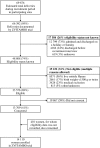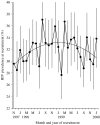HIV-1 and HIV-2 prevalence and associated risk factors among postnatal women in Harare, Zimbabwe
- PMID: 17217549
- PMCID: PMC2870654
- DOI: 10.1017/S0950268806007709
HIV-1 and HIV-2 prevalence and associated risk factors among postnatal women in Harare, Zimbabwe
Abstract
Studies of antenatal women form the predominant source of data on HIV-1 prevalence in Africa. Identifying factors associated with prevalent HIV is important in targeting diagnostic services and care. Between November 1997 and January 2000, 14,110 postnatal women from Harare, Zimbabwe were tested by ELISAs reactive to both HIV-1 and HIV-2; a subset of positive samples was confirmed with assays specific for HIV-1 and HIV-2. Baseline characteristics were elicited and modelled to identify risk factors for prevalent HIV infection. HIV-1 and HIV-2 prevalences were 32.0% (95% CI 31.2-32.8) and 1.3% (95% CI 1.1-1.5), respectively; 4% of HIV-1-positive and 99% of HIV-2-positive women were co-infected. HIV-1 prevalence increased from 0% among 14-year-olds to >45% among women aged 29-31 years, then fell to <20% among those aged>40 years. In multivariate analyses, prevalence increased with parity, was lower in married women than in single women, divorcees and widows, and higher in women with the lowest incomes and those professing no religion. Adjusted HIV-1 prevalence increased during 1998 and decreased during 1999. Age modified the effects of parity, home ownership and parental education. Among older women, prevalence was greater for women who were not homeowners. Among younger women, prevalence increased with parity and low parental education. None of these factors distinguished women co-infected with HIV-2 from those infected with HIV-1 alone. Prevalent HIV-1 infection is associated with financial insecurity and weak psychosocial support. The ZVITAMBO study apparently spanned the peak of the HIV-1 epidemic among reproductive women in Harare.
Figures




References
-
- Zaba B, Boerma T, White R. Monitoring the AIDS epidemic using HIV prevalence data among young women attending antenatal clinics: prospects and problems. AIDS. 2000;14:1633–1645. - PubMed
-
- WHO WHO; Geneva: 1994. . Evaluation of a national AIDS programme. A methods package.1. Prevention of HIV infection. WHO/GPA/TCO/SEF/94.1.
-
- UNAIDS/WHO/MEASURE Evaluation/USAID Geneva: UNAIDS/WHO; 1999. . National AIDS programmes: a guide for monitoring and evaluation. Draft,
-
- Mahomed K et al. Seroprevalence of HIV infection amongst antenatal women in greater Harare, Zimbabwe. Central African Journal of Medicine. 1991;37:322–325. - PubMed
-
- Mbizvo MT et al. Trends in HIV-1 and HIV-2 prevalence and risk factors in pregnant women in Harare, Zimbabwe. Central African Journal of Medicine. 1996;42:14–21. - PubMed
Publication types
MeSH terms
LinkOut - more resources
Full Text Sources
Medical

